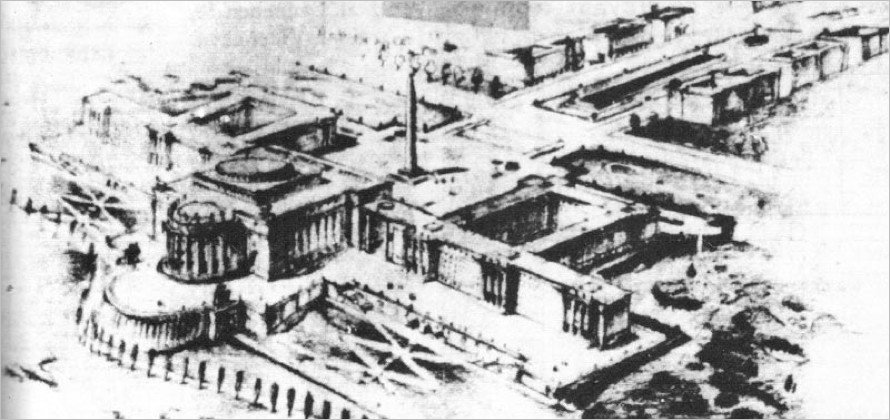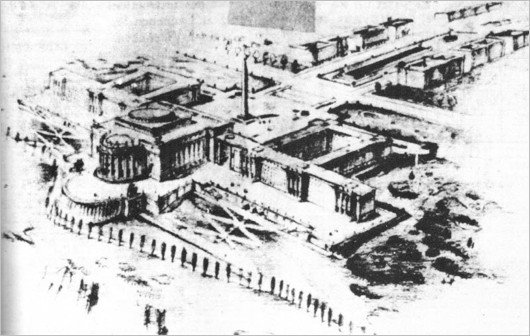

About Andrew Cusack
 Writer, web designer, etc.; born in New York; educated in Argentina, Scotland, and South Africa; now based in London.
Writer, web designer, etc.; born in New York; educated in Argentina, Scotland, and South Africa; now based in London. read more
News
Blogs
Reviews & Periodicals
Arts & Design
World
France
Mitteleuropa
Knickerbockers
Argentina
The Levant
Africa
Cape of Good Hope
Netherlands
Scandinavia
Québec
India
Muscovy
Germany
Academica
The UN at Quebec
IN 1943, THE BRITISH, Canadian, and American governments descended upon the city of Quebec, capital of la vieille province, for an intergovernmental conference to plan the invasion of France — surely one of the greatest military tasks ever undertaken in the modern era. The site proved auspicious due to a peculiar combination of factors: Quebec City enjoys a certain European cachet but with both the geographic safety of North America and the more spacious accommodation usual to that continent. The three governments held a second conference there in 1944, and in 1945 the International Labour Organisation met in the city, followed a few months later by the Food & Agriculture Organisation of the nascent United Nations.
With this track record of indisputable experience, the ville de Québec, lead by its mayor Lucien Borne, put in a bid to be the permanent seat of the United Nations Organisation. Borne commissioned the architects Adrien Dufresne and Édouard Fiset to design a Palace of the United Nations which would be sited upon the Plains of Abraham, where the Battle of Quebec took place.
The Gazette reported on the design:
The palace, in the architects’ idea, opens with a vast front Court of Honor on the enlarged St. Louis boulevard, and this is axed on the immense meeting hall capable of containing 4,000 delegates and spectators, and is preceded by rotunda (Salle des Pas Perdus) and surrounded by council rooms. On each side of the rotunda, two large open porticoes would connect two different services; the office of the secretariat of the League on one side, and the Library and various administrative services on the other. This ensemble looks on the St. Lawrence river and encircles, on the north, the front court. …
In front of the palace, on the city’s side, a monumental avenue would be lined by large hotels and embassies, the mould of which would regulate its aspect, according to the plan.
It would have proved a suitably dramatic location for the United Nations, overlooking the St Lawrence River, but the Preparatory Committee decided not to include Quebec City in its final list of candidates. Wary of the possibility of American isolationism, the majority of the United Nations preferred siting the permanent headquarters in the United States; European countries argued for New York or Philadelphia, while Australia, New Zealand, China, and the Pacific nations argued for San Francisco. Eventually, the Rockefellers bought the district of slaughterhouses in Murray Hill on Manhattan, and the United Nations has been headquartered there ever since. Quebec later offered to host the FAO, but was turned down yet again in favour of Rome in 1949.

Search
Instagram: @andcusack
Click here for my Instagram photos.Most Recent Posts
- In the Courts of the Lord February 13, 2025
- American Exuberant February 10, 2025
- Crux Alba Journal Launch February 10, 2025
- The Year in Film: 2024 February 10, 2025
- Articles of Note: 27 January 2025 January 27, 2025
Most Recent Comments
- on When an American aristocrat meets a European Grand Duke
- on The Year in Film: 2024
- on Jesuit Gothic
- on The Borough Synagogue
- on No. 82, Eaton Square
- on Christ Church
- on The Last Will and Testament of Louis XVI
- on Amsterdam
- on Season’s Greetings from the Seventh
- on Season’s Greetings from the Seventh
Book Wishlist
Monthly Archives
Categories



Apparently, another interesting contender for the UN headquarters at some stage in 1945-1946 was Navy Island on the Canadian side of the border in the Niagara River. Although inhabited at one point, it’s now a national park.
The island was considered ideal because of its location between two peaceful and sovereign countries, although in the 1830s, a band of Canadian rebels instituted a short-lived Canadian Republic there under the real or imagined protection of the United States government.